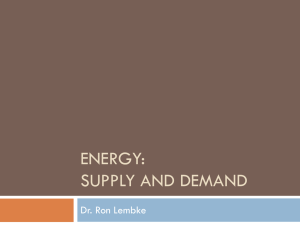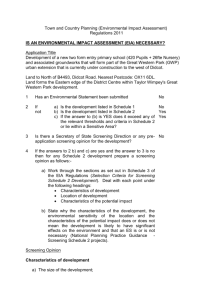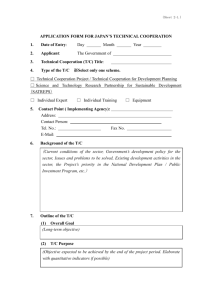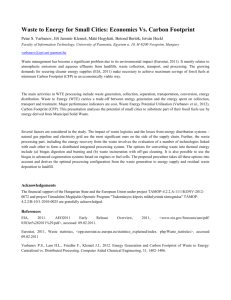EIA Nursery
advertisement
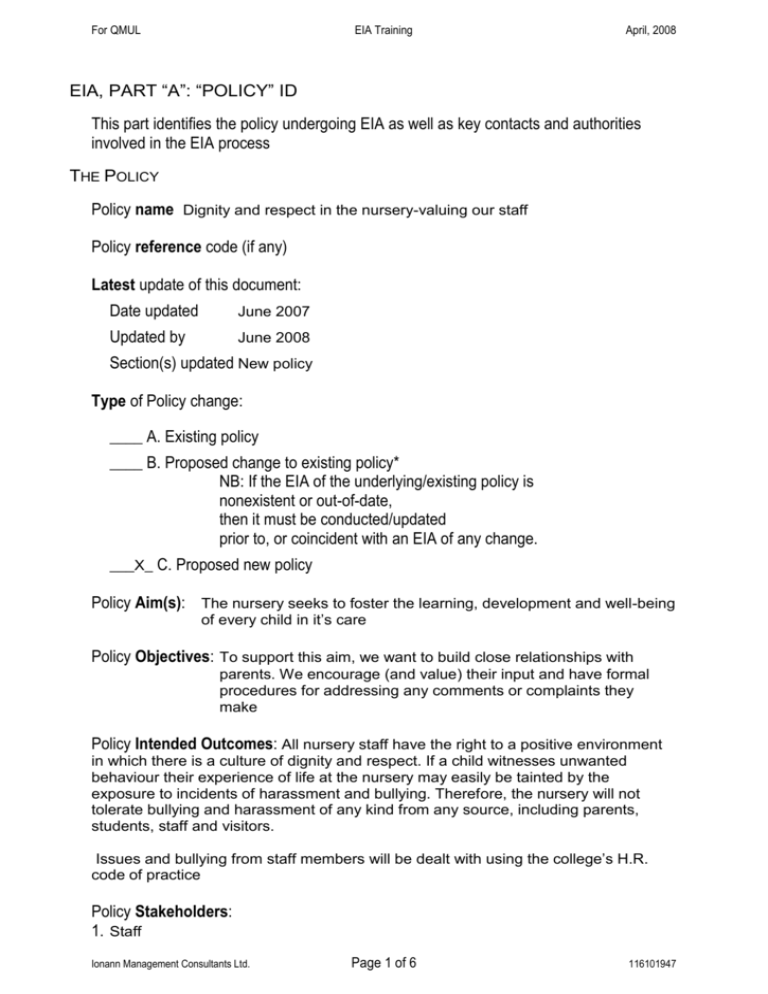
For QMUL EIA Training April, 2008 EIA, PART “A”: “POLICY” ID This part identifies the policy undergoing EIA as well as key contacts and authorities involved in the EIA process THE POLICY Policy name Dignity and respect in the nursery-valuing our staff Policy reference code (if any) Latest update of this document: Date updated June 2007 Updated by June 2008 Section(s) updated New policy Type of Policy change: ____ A. Existing policy ____ B. Proposed change to existing policy* NB: If the EIA of the underlying/existing policy is nonexistent or out-of-date, then it must be conducted/updated prior to, or coincident with an EIA of any change. ___X_ C. Proposed new policy Policy Aim(s): The nursery seeks to foster the learning, development and well-being of every child in it’s care Policy Objectives: To support this aim, we want to build close relationships with parents. We encourage (and value) their input and have formal procedures for addressing any comments or complaints they make Policy Intended Outcomes: All nursery staff have the right to a positive environment in which there is a culture of dignity and respect. If a child witnesses unwanted behaviour their experience of life at the nursery may easily be tainted by the exposure to incidents of harassment and bullying. Therefore, the nursery will not tolerate bullying and harassment of any kind from any source, including parents, students, staff and visitors. Issues and bullying from staff members will be dealt with using the college’s H.R. code of practice Policy Stakeholders: 1. Staff Ionann Management Consultants Ltd. Page 1 of 6 116101947 For QMUL EIA Training April, 2008 2. Parents 3. Children 4. Visitors (including childcare students) Ionann Management Consultants Ltd. Page 2 of 6 116101947 For QMUL EIA Training April, 2008 EIA, PART “B”: SUMMARY REPORT This part shows the scope of EIA required (none or screening or full), the principal stakeholders, overall assessment of the EIA. Also noted are consultations undertaken, key elements of the Action Plan (only in case of full EIA), and other summary comments. FOR THIS POLICY ____ (A) no EIA is required, because __X__ (B) only a screening (short-form) EIA is required (Part ‘C’ below) Date EIA process began: 20/5/08 Date screening EIA ended/approved: Date screening EIA report published ____ (C) a full (long-form) EIA is required (Parts ‘C’ thru ‘F’ below) Date EIA process began (as above): Date full EIA ended/approved: Date full EIA Report & Action Plan published PRINCIPAL STAKEHOLDERS: DIRECT & INDIRECT (1) Staff (2) Parents (3) Children (4) Visitors (including childcare students) OVERALL ASSESSMENT: Considered against relevant Equality standards in Law and Good Practice: X___ (A) this policy, as proposed, sufficiently meets/exceeds standard. ____ (B) this policy, as proposed, requires some revision, before implementation, to sufficiently meet standard. ____ (C) this policy, as proposed, requires significant revision, before implementation, to sufficiently meet standard. Policy aspects requiring revision to meet standards: ______________________________________________________________________ ______________________________________________________________________ Ionann Management Consultants Ltd. Page 3 of 6 116101947 For QMUL EIA Training April, 2008 CONSULTATIONS: With internal-only (QMUL-only) stakeholders Staff and parents ____________________________________________________________________ With external (non-QMUL) stakeholders Staff and parents KEY ELEMENTS IN ACTION PLAN PART “E” (ONLY IF ACTION PLAN IS COMPLETED) ___________________________________________________________________ ___________________________________________________________________ OTHER SUMMARY COMMENT: ___________________________________________________________________ ___________________________________________________________________ Ionann Management Consultants Ltd. Page 4 of 6 116101947 For QMUL EIA Training Programme April, 2008 EIA, PART “C”: SCREENING SHORT EIA This part documents the screening (short-form) EIA process which must answer the question (a legal standard), “Is the policy relevant to Equality & Diversity”? If the screening tests below show the policy is “relevant to Equality & Diversity”, then an assessment should be undertaken to see if there are any negative impacts that arise. If the screening tests below show the policy isn’t “relevant to Equality & Diversity” or does not have any negative impacts then only this screening (short-form) EIA is required to be completed, approved and published. A full EIA (Parts “D” through “F”) isn’t required. POLICY STAKEHOLDERS: THOSE DIRECTLY OR INDIRECTLY AFFECTED 1. Stakeholder identity Staff How affected by policy Can record a complaint if they need to. Specialist training is available for them to deal with difficult people or situations If a parent harasses a member of staff they may lose 2. Parents their child’s place at the nursery 3. Children Witnessing unwanted behaviour may taint the child’s life at nursery if exposed to incidents of harassment and bullying 4. Visitors Will not be allowed on the nursery premises SCREENING TESTS The following screening “tests” are a guide to determining “relevance to Equality & Diversity” TEST 1: POLICY IMPACT GROUPS Policy Impact Groups Will the policy Yes directly, or indirectly, impact: Students How? Evidence Yes, if a parent Yes, if a parent X X X Yes Staff Visitors Suppliers Partners Other: Children Ionann Management Consultants Ltd. No Page 5 of 6 116101947 For QMUL EIA Training Programme April, 2008 TEST 2: DIFFERENTIAL/DISPROPORTIONATE IMPACT Are particular groups of policy stakeholders (e.g., students or staff) likely to have different needs, experiences and/or attitudes for which the policy must take account? __X__ Yes. _____ No (evidence: _________________________________). Ionann Management Consultants Ltd. Page 6 of 6 116101947



